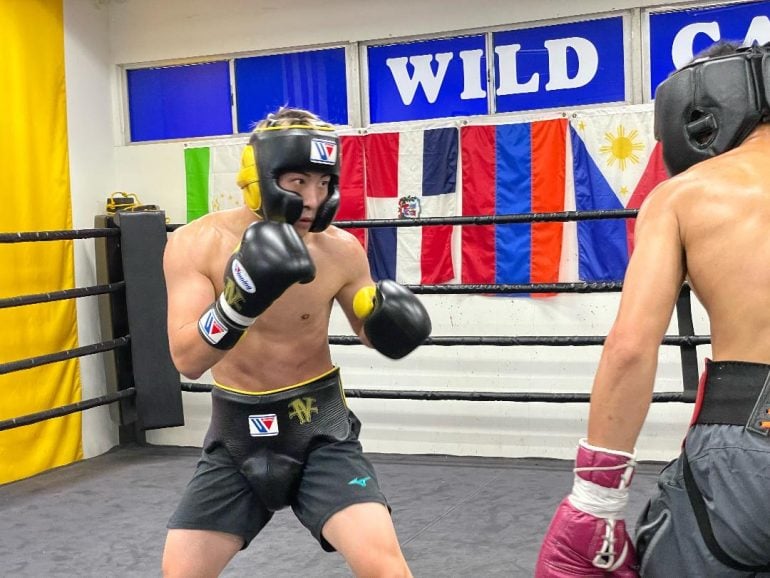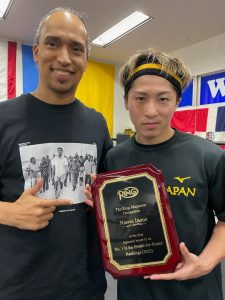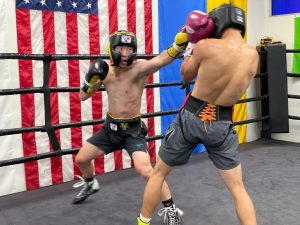Gym Notes: Naoya Inoue leaves ‘comfort zone’ for taste of L.A. boxing scene

Health concerns prevented me from traveling to Las Vegas to cover the Canelo Alvarez-Gennadiy Golovkin rubber match (don’t fret, it’s not life threatening and I’m getting better). It was a disappointing development because I covered the first two fights in 2017 and 2018 (also served as one of the commentators for the online PPV/international broadcasts) and, despite the official odds and concerns about GGG’s age, I expected the third bout to deliver something special.
The silver lining to staying home was the opportunity to watch Japanese star Naoya Inoue train, something few Americans have witnessed. As Canelo-GGG 3 approached, The Monster was in the final days of a two-week stay at Wild Card Boxing Club in Hollywood.

Your favorite EIC was pleased to present Naoya Inoue with an award recognizing him as the first Japanese boxer to top the mythical pound-for-pound rankings. Photo by Masa Ueda
Inoue’s training and sparring was closed to the public, U.S. media, and even most of the Japanese press that was aware of his California mini-camp, but I had a hunch I’d be allowed to slip in for one session. My gut was correct. (Hey, I came bearing gifts. What fighter doesn’t like being awarded a plaque recognizing his achievement? I also brought a bunch of his cover-debut issues of The Ring with me. I didn’t think he’d care about the magazines but he gladly snatched them up and then thanked me for being the tie-breaker in the Ring Ratings Panel vote that briefly advanced him to No. 1 in The Ring’s pound-for-pound rankings.)
So, on September 14, between 4:00-6:00 p.m. I watched Inoue and his brother Takuma go quality rounds with local standouts and then interviewed Naoya for this column. Unlike Canelo-GGG 3, the Inoue Brothers delivered.
It’s been a while since I’ve done this kind of article and I’ve missed it. Watching world-class sparring is an exhilarating experience for anyone, but the familiar faces that a longtime boxing observer bumps into at an established gym makes it feel like returning to one’s childhood neighborhood or attending a high school reunion.
I spotted former flyweight contender Willie Jensen as I walked into the parking lot. Jensen, a brilliant 1970s-era boxer who turned to coaching decades ago, trained me at the L.A. Boxing Club during the late 1990s. I excitedly called him by his name and he immediately corrected me:
“Come on, man, nobody calls me Willie, it’s ‘Birdlegs’ or ‘Birdman.’” I gave him a hug and started to walk with him up the steps to the main rooms of Wild Card but a rugged young man named Dickie called my name: “If you’re looking for Inoue, he and his team are in here.” He pointed to the private gym on the ground floor.
I said goodbye to the Birdman and hello to Team Monster, which was unsurprisingly small: Inoue’s father/trainer Shingo, assistant coach Akira Yaegashi, publicist Masa Ueda, three boxers – Naoya, Takuma and their cousin Koki – and two others who handled video for social media and helped assist the fighters during their stretching and floor exercises.
There was also a two-man film crew from NHK (Japan’s version of PBS) shooting a documentary for the network. They interviewed me for about 20 minutes before I left the gym. (I hope I get a chance to see the finished product.)
A temporary addition to Team Monster, Daisuke Okabe, needed no introduction. The Okayama native has lived in the Los Angeles area since 1995. I met him in 2000 or 2001 as a young assistant to veteran trainer/cornerman Rudy Hernandez (usually at the Maywood Boxing Club). Okabe, who still trains fighters with Hernandez, brought in all the sparring partners. Brief chats with him and Shingo (with the translation help of Ueda) revealed the sparring partner lineup to that point in the camp.
It was a very solid group that included featherweight fringe contender Adam Lopez (16-3, 6 KOs), The Ring’s No. 4-rated junior featherweight Azat Hovhannisyan (21-3, 17 KOs), and former two-time featherweight title challenger Joet Gonzalez (25-3, 15 KOs).
The day I was present, Takuma sparred four rounds with Saul Sanchez before Naoya went four brisk stanzas with Japhetlee Llamido. I know both Sanchez and Llamido from their appearances on Thompson Boxing’s monthly developmental series. But here are blurbs on each for those unfamiliar with the young guns:
Sanchez (18-2, 11 KOs), a 25-year-old bantamweight from Pacoima, is a rugged stalker-puncher. His deceptive speed and timing produced eye-catching opening-round stoppages on Boxeo Telemundo (Frank Gonzalez) and ShoBox (Ja’Rico O’Quinn) in 2021. However, he was narrowly outpointed by crafty Eros Correa in his most recent bout in June.
Llamido (9-0, 3 KOs), a 22-year-old featherweight from Norwalk, is a former amateur standout with a slick, mobile switch-hitting style. I described him as being “too much of a safety first boxer” while commentating on his most recent bout, a six-round decision over experienced journeyman Diuhl Olguin in July, so his father EJ had some words for me after the energetic gym session with Inoue. (Hey, it comes with the gig.)
Before I get into the details of either sparring session, allow me to fast forward to my interview with Naoya, which took place as he did his post-workout stretches. He was in a pleasant and thoughtful mood.
I learned this was not only his first camp in the U.S., but his first time training outside of his home gym in Yokohama.

Naoya can be a stoic interview before or after fights but he’s relaxed at the gym, even one halfway around the world from his home gym. Photo by Yours Truly
“Since my pro debut, 10 years ago, the only place I ever sparred was at the Ohashi Gym,” Inoue said through Ueda. “I wanted a change and I’ve always wanted to train in America.
“It’s something I’ve brought up to Mr. (Hideyuki) Ohashi [Inoue’s co-promoter with Top Rank] in the past, but the timing was never right. I probably would have come over sooner if not for the pandemic lockdown.
“The main purpose of this trip was to change the environment and everything that I’m used to. In Japan, I’m mainly sparring with the same boxers from Japan, the Philippines and Thailand. I know those boxing styles. I wanted to come here and experience American boxing, Mexican boxing, Russian and Armenian styles.
“This was different and challenging at times. I’m not used to ‘outsiders’ watching me train. Here, sparring partners bring their friends and family members along with their trainers, so I had a lot of people watching me spar. I think that made me stronger because I was forced to focus when I was out of my comfort zone.”
TAKUMA-SANCHEZ
Takuma is a well-rounded boxer who lacks his older brother’s gift of world-class power as his KO ratio (only 3 stoppages in 16 victories) suggests. He’s got a straight-forward orthodox style I thought would mesh well with Sanchez’s aggression. Sanchez, who was frustrated by the constant movement of Correa, would not have to look for Takuma. However, Takuma’s speed, punch variety and angles on the inside seemed too much for Sanchez to deal with for two and half minutes of the opening round.
I was impressed with Takuma’s footwork and coordination. In some ways, he looked like a more fluid version of his brother. Sanchez stalked behind a high guard, but was beat to the punch by Takuma’s sharp jab and select body shots. I was thinking Takuma might outclass Sanchez to an embarrassing degree until the local kid managed to pin him to the ropes and tag his body during the final 30 seconds of the round.

Saul Sanchez (red gloves, headgear and cup) tries to push Takuma to the ropes. Photo by Yours Truly (which is why it sucks)
Sanchez made the session as rough as he could going forward. He immediately closed ground on Takuma in Round 2, attacking the body and head. Takuma stood his ground and did his best to block and counter with uppercuts and his own body shots.
Sanchez, clearly on a mission to get respect, loaded up on right crosses and left hooks in Rounds 3 and 4. Takuma continued to land his uppercut in close, which would earn him a few seconds of breathing space. If Sanchez didn’t fire back, Takuma feinted his way back inside and tried to bully the bull. This worked for 20 or 30 seconds at a time until Sanchez took a step back and popped his jab and one-two combinations. The right hands landed hard, causing Takuma to hold. Sanchez then walked him to the ropes where both were comfortable exchanging out of high guards. Takuma defended and landed well from this position but he was outworked by Sanchez.
My immediate assessment following the session: Takuma has beautiful moves and textbook technique, but he will either need to commit to a stick-and-move style that better controls distance or improve his infighting ability before he takes on the world-class junior featherweights. (He recently cracked The Ring’s 122-pound rankings, but the Ratings Panel only grudgingly OK’d his entry at the No. 10 spot.)
NAOYA-LLAMIDO

Naoya fires his jab at Japhetlee Llamido, who seemed ready for every punch. Photo by Masa Ueda
The opening minute of Round 1 was a contest of jabs as they jockeyed for position. Llamido connected first, spearing Inoue’s stomach with a hard jab. Inoue instinctively countered with a straight right. Surprisingly, Llamido was ready for it. He not only slipped the punch, he closed ground and dropped a three-piece combination to Inoue’s body and head. Llamido was not intimidated by the bantamweight champ. He remained in the pocket and landed a right to the body. Inoue was able to block punches, but seemed a little tight. With a minute to go, Inoue landed a hook to the body that made a loud “smacking” noise. Llamido kept his composure but was nailed with a jab-straight right-to-the-body combo. He spun out of range as Inoue aimed a one-two to his face. Llamido then took the fight to Inoue in the final seconds of the round, landing a crisp right to Inoue’s cheek at the bell.
I was surprised Llamido did as well as he did. I’d never seen him box this aggressively, let alone hang close with an elite-level boxer, but I should’ve expected more from him. I’d forgotten that Llamido spent a month in Yokohama in 2019, sparring with both Inoue brothers as they prepared for a big doubleheader (Takuma’s WBC bantamweight title shot vs. Nordine Oubaali and Naoya’s World Boxing Super Series final vs. Nonito Donaire).
Team Llamido was familiar with the Inoue-style of fighting. “They love the right-hand counter over the jab,” EJ told me after the session. “That’s their pet move, but we were ready for it.”

Llamido knew how to use his height and reach effectively. Photo by Masa Ueda
Llamido continued to make full use of his height and reach advantage while employing a smart-but-bold boxing style. He connected with a right cross at the start of Round 2. Inoue fired his jab like a power punch. Llamido took a page from Inoue’s book by countering with a right over the top. Inoue switched his focus to the body, just “touching” with a right to the head then banging the ribs with his left. Llamido did his best to block the body shots and stay just out of range, sometimes dropping his hands to try to lure the champ in. Inoue landed a big right with a minute to go. Llamido tried to retaliate but Inoue proved to be elusive to the bell.
It was fascinating to see Inoue slip and slide away from punches on the back foot. But controlled aggression is his bread and butter and he got back to that in Round 3. Inoue backed Llamido to the ropes with well-timed power jabs and right hands. A fast lead right followed by a double hook from Llamido temporarily got him off the ropes, but Inoue continued applying steady pressure. Inoue was clearly measuring Llamido for a big shot, and he landed one – a right hand – with Llamido on the ropes. Llamido took it well and came back with a short hook. Inoue banged him again with a single right, followed by a hook to Llamido’s side. Both fighters abandoned combination punching as they took turns stalking the other to the ropes. Both were comfortable counterpunching while on the ropes. Inoue punctuated the round with a stiff jab to Llamido’s face.

I wish we were able to catch one of the exchanges, but hey, Masa is a publicist; I’m an editor/writer. Next time we’ll get ace photographer Naoki Fukuda in the gym. Photo (and it’s a nice shot) by Masa Ueda
Inoue began Round 4 with a right-cross bomb that twisted Llamido’s body halfway around. Llamido wisely got on his bike for the next 20-30 seconds as he cleared his head, but then gamely stood his ground and tried to counter Inoue’s attack. Llamido’s body shots seem to be his most effective punches even as he was pushed back on his heels. Inoue remained on the hunt, loading up with his own body shots as the final minute of the session ticked away. Inoue was determined to assume and keep command, while Llamido was willing to empty his tank and let his hands go, making for a hotly contested final seconds of the round.
If Llamido went all out like that during one of his Thompson Boxing bouts, Beto Duran and I would have nothing but praise for him during the live streams. I said this to EJ Llamido, who countered: “Why go all out in a six- or eight-round fight when you could get cut from a headbutt or suffer a hand or rib injury? That happens and you’re out of the ring and the gym for months.”
Fair enough. “Now you know that he can fight on this level,” EJ continued. I’m a believer. It was nice chatting with Japhetlee and his girlfriend Stephanie Chavez, a pro boxer who worked his corner.
“He hasn’t changed since we sparred in 2019,” Llamido said of Naoya. “He has a really good jab and his timing is superb. He’s got power in both hands, but it’s his timing that drops guys.”

Naoya signs Stephanie’s T-shirt. He’s a cool cat. Japhetlee returns on the Oct. 29 JoJo Diaz-William Zepeda undercard on DAZN. Photo by Yours Truly
Chavez was proud of her partner.
“I see them as similar boxers, they’re both fast with crazy timing,” she said. “We came to this session with a game plan and that was to pick shots as sharp as possible and to find (Inoue’s) uncomfortable spot. It’s not easy because of his power and timing, but it’s there if you can get in close and follow through punches. You can’t just cover up when he punches. You have to press him and stay with him. He’s not used to that.”
If it sounds like Chavez isn’t a fan of The Monster, think again. She wore a “Naoya Inoue” T-shirt in her boyfriend’s corner and later had Inoue sign it.
My immediate assessment after the session: When Naoya moves up in weight he will encounter fighters with significant height and reach advantages, some of whom will be able to take his power. Llamido knew what to expect from Inoue. The elite junior featherweights, such as Stephen Fulton and Murodjon Akmadaliev, will also be well prepared for his dynamic style of boxing.
While Koki Inoue sparred with Ruben Rodriguez (a Robert Garcia-trained junior welterweight from Indio with a 10-1 record), I chatted with Naoya and Yaegashi (with Ueda’s assistance).
“I knew Japhetlee was a skillful boxer,” Naoya said. “I like a sparring partner who can adjust to whatever I do. I want to practice my skills when I spar.”
Yaegashi, a recently retired former champion, could tell that Inoue was not as athletic as usual.
“We’re coming to the end of this camp and I suspect he’s getting a little tired,” said the veteran, who held world titles at strawweight, junior flyweight and flyweight. “But he still boxed well. That’s one of Naoya’s strong points, he stays focused through fatigue.”
Yaegashi was most impressed with Inoue’s sessions with Adam Lopez.
“Naoya was at his peak with Lopez,” he said. “But it was still a thinking sparring session. They’re both smart, both good at baiting and setting traps. It was a chess match, and very good preparation for (WBO bantamweight titleholder Paul) Butler.”
Inoue-Butler is reportedly set for December 13 in Japan. If Inoue beats the British boxer (as everyone expects) he will achieve undisputed status at bantamweight and likely look to make moves in the 122-pound division in 2023. (And what I mean by “likely” is definitely, he looked to be a solid 135 pounds at Wild Card.)
A wider variety of boxing styles comes with the heavier weights, I noted to Naoya. “You might want to consider more camps – longer camps – in Los Angeles next year,” I said.
“Count on it,” he said.
Read RingTV’s exclusive two-part Q&A with Inoue:














